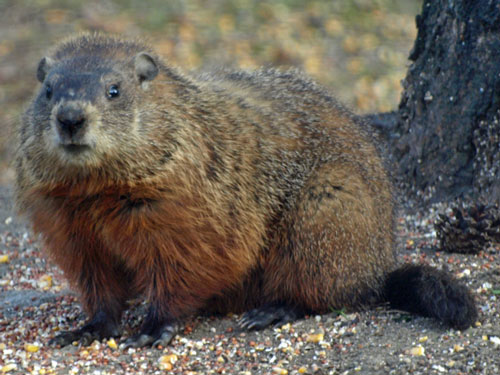Who doesn’t admire our military snipers? Shame on you if you don’t. I admire them so much I emulate them in almost every hunting season I participate in including predator and varmint hunts. For those of you who can’t stand to watch woodchucks chucking wood then a sniper-style hunt for these Weight-Watcher-ignoring rodents is the perfect outing. Don a ghillie suit and chamber a round.
Woodchucks, like many rodents, only take the so much shooting pressure before they realize that the sight of a truck pulling up to a field edge 500 yards away isn’t likely going to end with a visit from the welcome wagon lady. This is the exact reason to use sniper tactics for a chance to tip over a few of the pudgy, pasture grazers.
 Woodchucks inhabit a large swath of the American countryside with Pennsylvania being the unofficial woodchuck capital. Why? I’m sure it has something to do the Pennsylvania’s most famous resident rodent, Punxsutawney Phil, the Weather Channel woodchuck. If Boone and Crockett ever started measuring woodchucks I’m quite positive Phil would be in the “Booner” category.
Woodchucks inhabit a large swath of the American countryside with Pennsylvania being the unofficial woodchuck capital. Why? I’m sure it has something to do the Pennsylvania’s most famous resident rodent, Punxsutawney Phil, the Weather Channel woodchuck. If Boone and Crockett ever started measuring woodchucks I’m quite positive Phil would be in the “Booner” category.
For those of you chomping for a rodent adventure the eastern half of the country sits perfectly in the zip code of the granddaddy rodent. From the Carolinas north you’ll find these big chompers along wooded edges and roaming fields for forage. You can also spy them throughout the Midwest with the Great Plains being the dividing line of where their habitat abruptly stops. You can hunt a relative of the woodchuck, they yellow-bellied marmot, in Western mountain regions. Make sure seasons are allowed before packing the varmint rig.
Now back to woodchucks. A big male can push the needle on a scale to 13 pounds. That much body weight means one thing: a hungry rodent. Landowners often welcome the serious shooter to keep woodchuck numbers in check, especially around crops and cattle pastures.
The pioneer spirit of Americans has been good for woodchucks due to the opening of eastern forests, Midwestern woodlots and the overall expansion of farming. Travel anywhere around the eastern half of the country and look for rolling meadows, pastures and woodland edges for signs of Phil’s relatives.
Like most rodents, some of what they do is good for the landscape. Woodchucks aerate the soil as they dig and they keep certain species of native grasses and forbs clipped creating preferable, ever-growing browse for other wildlife neighbors. Of course they can also wreak havoc on a clover or alfalfa field annoying even the friendliest of farmers. They can also destroy a small whitetail food plot handily.
Landowners and farmers generally don’t mind the removal of a few of the crop-raiding rodents. Early spring is primetime for shooting as is midsummer when young chucks leave the den. Woodchucks are most active in the mornings and late afternoon.
Your coyote rig is perfect for pounding these pesky rodents with popular calibers including the .17 Hornet, .204, .222, .223 and the .22-250 or whatever you dream up in a wildcat caliber. Shots can vary, but 200 yards is probably the norm. You’ll need to be sneaky and make one-shot kills, hence the ghillie suit suggestion. Missed chucks rarely pop their head out of a den until after a long thought process.
One interesting note, if you hunt in Pennsylvania an orange hat is required even though the season is year-round. Shooting is limited during deer and turkey season, plus it is closed on Sunday. Make sure to check your state regulations, but don’t miss this unique opportunity for a challenging hunt between fur seasons.






